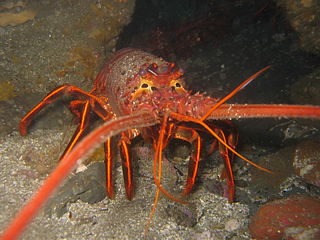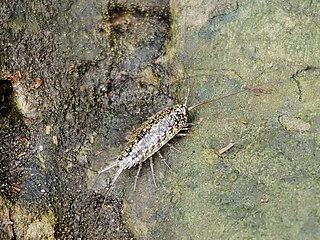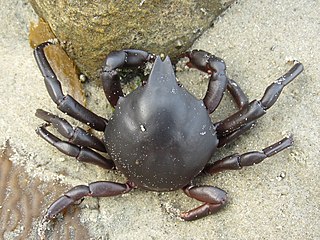 W
WBellorchestia quoyana is the largest and most common species of sandhopper, endemic to New Zealand. Its length is up to 14 millimetres (0.55 in). They help to keep the beaches clean by breaking down any organic material, which is vital for plant succession. They are nocturnal and bury themselves up to 30 centimetres (12 in) during the day.
 W
WBlepharipoda occidentalis, the spiny sand crab or spiny mole crab, is a species of sand crab or mole crab which lives in the eastern Pacific Ocean, from Central California to Baja California. It is oval in shape, growing up to 3 inches (76 mm) long and 1.75 in (44 mm) wide. It lives on sandy beaches up to 30 metres (98 ft) under water, and feeds on the remains of other sand crabs that live in the area.
 W
WCalcinus laevimanus is a species of hermit crab in the genus Calcinus found in the Indo-West Pacific region, the type locality being Hawaii. It is also known as the blue-eyed hermit crab, zebra hermit crab, dwarf zebra hermit crab, left-handed hermit crab, Hawaiian reef hermit and other similar names.
 W
WThe California spiny lobster is a species of spiny lobster found in the eastern Pacific Ocean from Monterey Bay, California, to the Gulf of Tehuantepec, Mexico. It typically grows to a length of 30 cm (12 in) and is a reddish-brown color with stripes along the legs, and has a pair of enlarged antennae but no claws. The interrupted grooves across the tail are characteristic for the species.
 W
WEnoplometopus occidentalis, the red reef lobster, Hawaiian reef lobster, or hairy reef lobster, is a reef lobster, native to the Indo-Pacific Ocean. It is in the family Enoplometopidae.
 W
WHemilepistus reaumuri is a species of woodlouse that lives in and around the deserts of North Africa and the Middle East, "the driest habitat conquered by any species of crustacean". It reaches a length of 22 mm (0.87 in) and a width of up to 12 mm (0.47 in), and has seven pairs of legs which hold its body unusually high off the ground. The species was described in the Description de l'Égypte after the French Campaign in Egypt and Syria of 1798–1801, but was first formally named by Henri Milne-Edwards in 1840 as Porcellio reaumuri. It reached its current scientific name in 1930 after the former subgenus Hemilepistus was raised to the rank of genus.
 W
WLigia baudiniana is a woodlouse in the family Ligiidae. It has a coarsely granular surface and large eyes that are very close together.
 W
WThe striped shore crab, also known as the lined shore crab, is a small crab found on both rocky and hard-mud soft seashores of the northeastern and northwestern Pacific Ocean. In North America, this species occurs from central Oregon, south through California to near Ensenada, Baja California, Mexico. There is an isolated population with a wide range disjunction at Bamfield on Vancouver Island, Canada. The western Pacific population, including both Korea and Japan is isolated with a divergence time from the eastern Pacific population estimated between 0.8 and 1.2 Mya.
 W
WPugettia producta, known as the northern kelp crab or shield-backed kelp crab, is a species of crab in the family Epialtidae.
 W
WTaliepus nuttallii, known generally as the southern kelp crab or globose kelp crab, is a species of true crab in the family Epialtidae. It is found in the East Pacific.